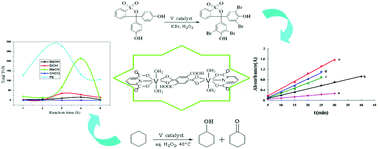Two novel vanadium(III) complexes: V(dipic)(Hbdc)(H2O)2 (1) and [V2(dipic)2(H2btec)(H2O)4]·2H2O (2) (H2dipic = 2,6-pyridinedicarboxylic acid, H2bdc = 1,3-benzene-dicarboxylic acid, H4btec = 1,2,4,5-benzenetetracarboxylic acid) are synthesized by the reaction of V2(SO4)3, 2,6-pyridinedicarboxylic acid and 1,3-benzene-dicarboxylic acid (for 1) or 1,2,4,5-benzenetetracarboxylic acid (for 2) under hydrothermal condition at 120 °C for 3 days. They were characterized by elemental analysis, IR, UV-Vis, single crystal X-ray diffraction analysis and thermogravimetric analyses (TG). Structural analyses show that the vanadium atoms in the complexes 1 and 2 are both in a pentagonal-bipyramidal coordination environment with the NO6 donor set, and there is intermolecular hydrogen bonding in each complex. Research results found that the complexes exhibited bromination catalytic activity in the single-pot reaction of the conversion of phenol red to bromophenol blue in the mixed solution of H2O–DMF at the constant temperature of 30 ± 0.5 °C with pH = 5.8, and catalytic C–H bond cleavage activity for the peroxidative oxidation (with hydrogen peroxide) of cyclohexane to cyclohexanol and cyclohexanone (the maximum total turnover number is 395) under the mild conditions.


 Please wait while we load your content...
Please wait while we load your content...